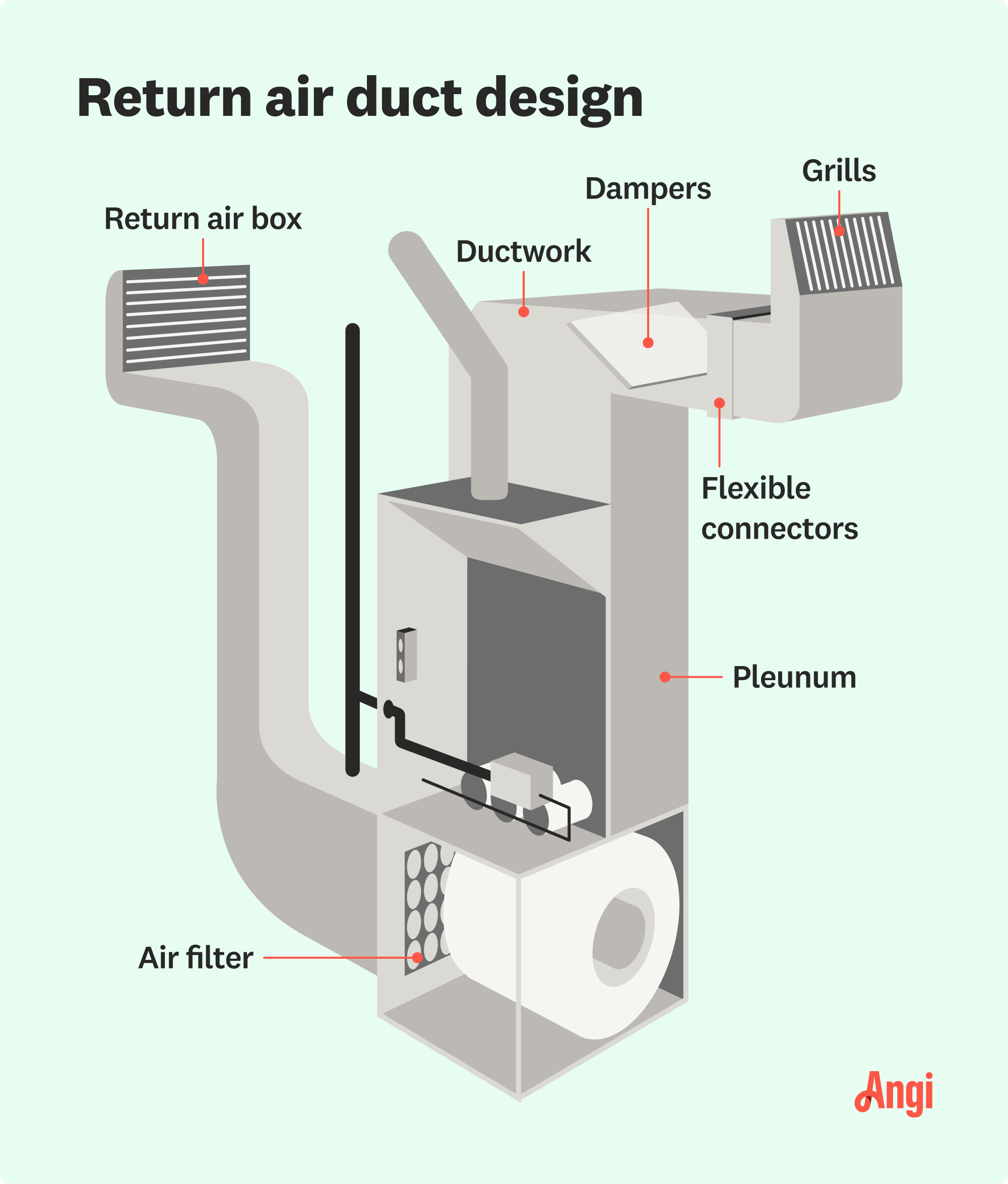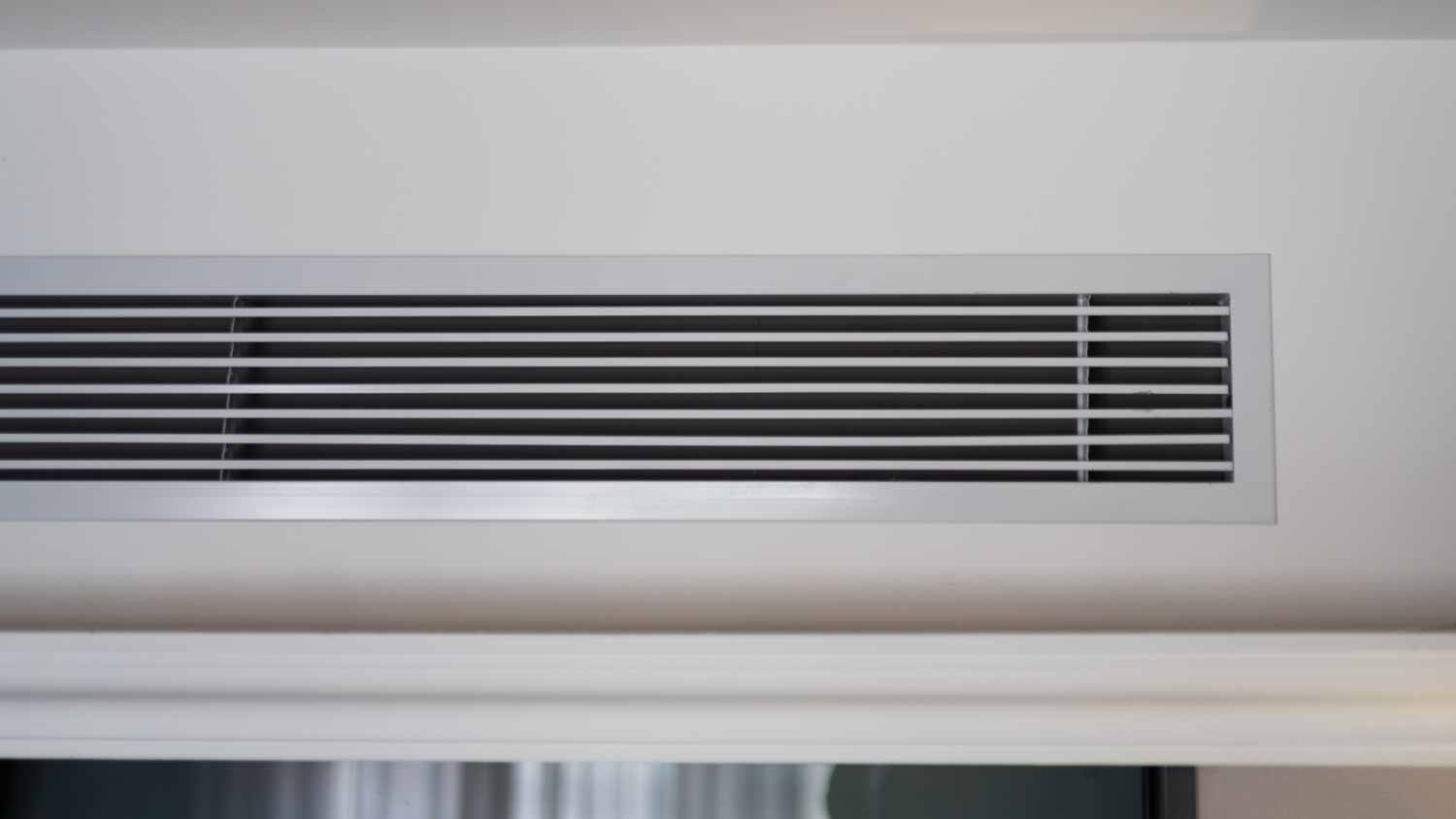
Gas furnace replacement costs depend on the type of furnace you want and installation fees. Our guide explains all the factors involved in a new furnace cost.
Essential components for optimal HVAC function


The return air duct helps pull air from a room into your HVAC system.
Homeowners can complete some return air duct maintenance tasks.
Air duct replacement costs $450 to $2,180, depending on the size of the home.
You enjoy the fresh, comfortable air from your home's HVAC system—but have you ever wondered how the air gets drawn in? That's where return air ducts come in.
Your home's return air duct system has several important parts that help your HVAC system work smoothly. Each part is key in balancing airflow and filtering your home's air. Learn about return air duct design to better understand how your HVAC works.
HVAC systems feature two main air functions: return air versus supply air. Return air is drawn from the rooms back into the HVAC unit for reconditioning and recirculation. Supply air is the conditioned air that comes out of the HVAC unit to provide heating or cooling.

Return air grills, sometimes called registers or vents, are the entry points for air to return from the rooms to the HVAC system. Grills are installed on walls or ceilings and designed to be aesthetically pleasing while providing adequate airflow. How many return vents you need depends on the size of your home.
This part of the ductwork carries the air from the return air grills back to the HVAC unit. They can be made from various materials, including sheet metal, fiberglass, or flexible ducting. Proper sizing and installation are crucial to minimize resistance and noise.
Plenums are large ductwork sections connected to the HVAC unit that distribute the return air to the individual return ducts. There are two types of plenums in a return air system: the return plenum and the supply plenum. The return plenum collects air from return ducts and directs it to the HVAC unit.
Located in the return air path, air filters remove dust, debris, and other particles from the air before they re-enter the HVAC unit. Regularly maintaining and replacing these filters are essential for good indoor air quality.
This component, located near the HVAC unit, collects air from multiple return ducts and directs it into the return plenum. It acts as a central hub for the return air system.
These are adjustable dampers installed in the return ducts to control airflow and balance the system. They help ensure the return air is evenly distributed from all rooms, optimizing system performance and comfort.
These connectors reduce vibration and noise transmission between the return air ducts and the HVAC unit. They provide flexibility and prevent rigid connections that could transmit noise and vibrations.
In zoned HVAC systems, zone dampers control airflow to different areas or zones within the home. These dampers are located in both supply ducts and return ducts. As part of the return air duct system, zone dampers regulate the return air from each zone. If you're wondering how to identify supply and return ducts, you can perform a simple test on the vents to see whether the air blows in or out.

Maintaining the components of a return air duct system will help keep your indoor air quality high. Many of the maintenance tasks are DIY-friendly. You can regularly inspect and clean return air grills and ducts to prevent dust buildup, which can restrict airflow and reduce system efficiency.
You should also replace air filters and adjust balancing dampers according to the manufacturer’s recommendations.
More complex maintenance tasks, such as inspecting and maintaining plenums, return air boxes, and flexible duct connectors, should be left to your local HVAC technician. HVAC pros can identify and repair leaks, which will save you money in energy costs.
Quality ductwork will increase the efficiency of your HVAC, sometimes by 20% to 30%. This is because there is reduced air leakage due to better insulation and more optimized airflow. This means your HVAC doesn't have to work as hard to keep the desired temperature, so it uses less energy.
Deciding whether to repair or replace return air ducts depends on the extent of damage and overall condition of your ductwork. Common return air duct problems include poor airflow, increased energy bills, excessive dust, and strange noises. If repairs don’t improve system performance, it’s time to consider a full replacement.
Minor issues such as small leaks or loose connections can often be repaired. However, significant damage, such as large holes, extensive rust, or corrosion, warrants duct replacement. Consult an HVAC technician to assess the condition of your ductwork and provide recommendations. They have the expertise to determine the most cost-effective and efficient solution, whether that involves repairing or replacing the ducts.
HVAC repair costs for ductwork range between $500 and $2,000, while the average air duct replacement cost ranges between $450 and $2,180, with most homeowners paying around $1,250.
Home size factors into the cost as well. Replacing air ducts in larger homes could cost as much as $9,000. The cost to reroute ductwork ranges between $1,500 and $9,000.
Whether to DIY or hire a pro to repair or replace a return air duct depends on the scope of the work. Confident DIYers can certainly handle sealing small leaks or even replacing short sections of ductwork.
However, more extensive damage leading to poor airflow or a full-on duct replacement requires an HVAC professional. Duct installers near you ensure proper installation, improving air quality and lowering energy bills. If you're unsure what to do, consult a professional who can help determine whether a DIY fix is sufficient or if expert intervention is needed.
From average costs to expert advice, get all the answers you need to get your job done.

Gas furnace replacement costs depend on the type of furnace you want and installation fees. Our guide explains all the factors involved in a new furnace cost.

Factors such as labor and parts impact the final price of repairing a window AC unit. Learn all of the costs associated with window air conditioner repair.

If your furnace is malfunctioning, it could be a faulty control board. Find out what a furnace control board replacement costs for parts, labor, and more.

Prepping your furnace can extend the life of your unit and stop costly repairs. Follow these furnace maintenance tips for a warm, stress-free winter.

Condensation on air vents suggests something is wrong with your HVAC system. Learn how to stop condensation on air vents through preventive measures.

Energy bills rising? Here’s how to perform a DIY duct leakage test to locate any damage in your ductwork and restore your energy-efficient home.